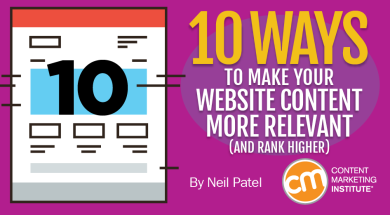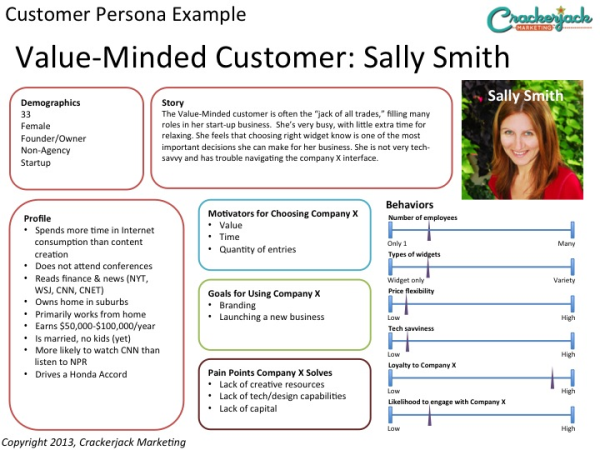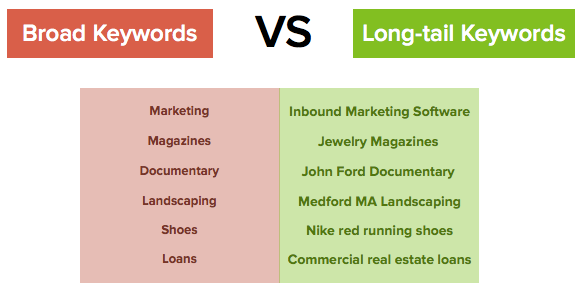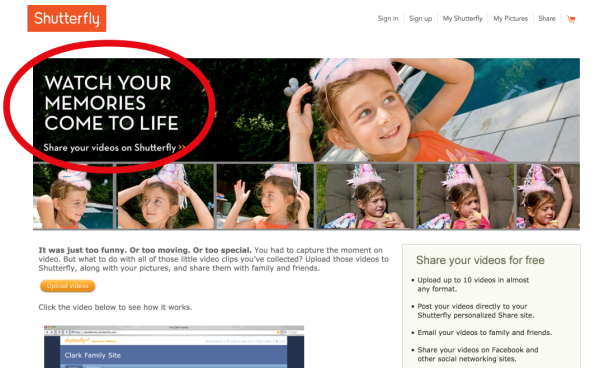
It’s absolutely critical that brands achieve relevance. One of the primary methods for accomplishing relevance is to create relevant content.
Unfortunately, an aura of mystery surrounds the concept of relevance. It’s misunderstood as a stylistic thing, flair, or something that some writers “just have.” In reality, relevance is more scientific and systematic. You can create relevant content by understanding what relevance is and developing a process to achieve it.
The major upside of relevance is that you can accomplish major ranking uptick by creating relevant content. Here’s how to do it.
1. Start with a customer persona
There’s no such thing as content that will be relevant to everyone. Relevance is completely audience-dependent.
Part of the reason why relevance seems mysterious is because it is often viewed as a static entity – something that you can attain or achieve. In reality, relevance is a dynamic force. It is born in the identity of the user and responded to in the content of the marketer.
Relevance is more of a conversation than it is about cool design, a trendy logo, a stylistic flair, or the right colors.
That’s why you need to create a buyer persona or a customer persona. You need to understand your users before you can ever hope to be relevant to them.
Here is an example of a customer persona.

The persona can be as detailed as you want, complete with pictures or a snazzy design.

A persona should capture the basic essence of who is buying your product, and why they’re buying it.

The fact that they may drive a Honda Accord or have a blond 5-year-old nephew is not important by itself. The important things are the motivations and problems that the customer is experiencing.
Only by understanding who the customer is can you address her problems, her questions, her concerns, her interests, and enter into her world. Relevance begins with knowing.
If you’re lucky, you already have a persona somewhere buried deep within your marketing materials. If you don’t have a persona, create one. It will be well worth your time.
2. Understand user intent
Yes, I have to insert a boring SEO point here. I’m doing so not because I’m obsessed with SEO, but because I’m aware that search intent is the starting point for successful SEO.
Many SEOs and marketers think that the first thing they need to do when starting “SEO” is to make a list of keywords.
This is a mistake.
How are you going to come up with this list of keywords? You don’t simply pull them out of thin air. You strategize your keyword list by intuiting your user’s intent. You come up with that user intent by knowing your users – the persona described in Step 1.
Don’t put the relevant content cart before the horse.
User intent is the horse – the drive behind keywords. Here’s the definition:
The user intent of a keyword is the goal of the user typing the search query, and it typically falls into three categories: Do something, know something, or go somewhere. In fact, there’s often more than one intent per query.
Thankfully, there is a predefined set of three main things that a user searches:
- Do something – commercial queries: “Buy a lawn mower online”
- Know something – informational queries: “2015 gas lawnmower customer reviews”
- Go somewhere – navigational queries: “Craftsman website”
As you develop your keywords through research and analysis, you must pay close attention to the nature of the queries – their intent. That way, you can understand what your users want, and how to create relevant content for them.
3. Create a list of keywords
Remember, relevance is all about the user. If you’re going to get the user to click and engage with your copy, you need to use the right words/queries.
You’ll have to do a little SEO – not anything advanced or voodooish, but the basic idea of using the right words in the right places.
Here’s how Search Engine Land explains it:
Just use common sense. Think about the words you want a page to be found for, the words you feel are relevant from your keyword research. Then use them naturally on the page.
SEO is really about user experience. It’s delivering the right content for the right users, and making sure that they have a positive and rewarding experience.
Yes, you’ll need keywords.
How do you come up with these keywords? Ask:
- What are you selling? What is the nature of your business? Create a list of keywords that describe your product (navigational and commercial queries).
- What problem is the target customer experiencing or what solution does the customer want? Create a list of keywords that describe that problem and solution (informational queries).
As you develop this list, be aware that there are different types of keywords. The ones that will generate the best traffic are long-tail specific keywords as described by HubSpot:

Broad keywords are called head terms. Unless you’re Apple, Amazon, or Wikipedia, you’ll have a tough time ranking for these terms. Instead, use long-tail keywords:

4. Do SEO
Now, it’s time to put these keywords into play on your website. I used the heading “Do SEO,” which sounds elementary. Allow me to be specific.
Any successful optimization involves putting the right keywords in the right places. Each page on your website should be targeting a specific keyword. Your home page should be targeting the most important keywords. All the supporting pages on your website should target the supporting keywords.
Here is how to use your keyword:
- Use a variation of the keyword in the page title.
- Use a variation of the keyword in the H1 header.
- Use a variation of the keyword in the content itself.
- Use a variation of the keyword in any image alt tags.
Those are the four most essential elements of on-page SEO. If you use your keyword or some semantic variant, then you’ve “done SEO.”
How does this play into relevance?
Simple. Remember, the users are looking for some thing; they have an intent when they search. They type a query that matches that intent. If your website is successful at targeting that keyword, then you will rank in their query.
You have to “do SEO” to be relevant. What good is your website if it’s not relevant enough torank in the search engines? You have to be relevant not just for users but for search engines too.
5. Put keywords in your meta description
The meta description is a bit of code in your web page header that displays in the search engine result pages, and tells users what the page is all about.
Meta descriptions don’t directly boost SEO. They speak to the user. If a user searches “top lawn mower reviews,” it sees a list of results with meta descriptions for each site.
What makes a user click on a result? There are several things:
- Relevance of the title
- Relevance of the website URL
- Relevance of the meta description
If the meta description is relevant, it probably contains one of the keywords or phrases that the user seeks. If it doesn’t contain the keyword itself, then it should at least describe the nature of the keyword.
Here’s an example of how these several meta descriptions accomplish the goal of relevance:

6. Write meta descriptions in a sizzling hot style
Not only should the meta descriptions contain a keyword or related word, but they should have great style.
Remember, when you write a meta description, you’re not trying to game the search engine; you’re inviting the searcher to check out your website.
This is where the rubber of relevance meets the road. Style does play a part in relevance. If you can use the limited space in your meta description to nail the searcher’s problem, match her intent, and score her interest, you’ve won.
As an example, let’s say that a user is looking for a way to share her videos with friends. She types in “online video sharing.”
What does she see? This meta description. It entices her to click because it tells her how the link will help solve her need and precisely matches her intent. Plus, it contains a call to action.

7. Create a compelling summary or objective statement
When the users click from the search engine results page to your site page, the first thing they see needs to establish relevance.
Stylistically, the best way to show relevance is through a big fat headline. State the page’s objective in a few quick keywords or lines. This is where you bring the whole idea of the page into focus.
It doesn’t matter whether the page is a blog, an evergreen content page, or even your home page. You can accomplish relevance instantly by creating a summary headline.
To carry on the Shutterfly example, notice how it shapes the page – a powerful and brief headline:

8. Solve a problem
Now to bring the page directly to bear on the user’s interest, what kind of content should you create?
The idea here is simple. Solve a problem.
Find out what condition or problem the user is experiencing, and solve it. That’s what great content marketing does: It assesses the user’s need and creates a solution.
And that’s how and why it becomes relevant.
The user’s problems become fodder for your keyword focus, and then for your content marketing strategy. As you solve users’ problems, you’ll become good not just at ranking in the SERPs but also in dominating – creating content that is laser-focused on users.
Users will love the content because it solves their problems … because it’s relevant.
9. Make sure it is timely
Relevance has a chronological angle, too. You can’t expect to be relevant just by trying. You must ensure that your content matches current events, whatever those may be in your niche.
There are two angles to establishing relevancy with timely content:
- Use your blog and social media strategy to post about and write about current events.
- Use your website’s content pages to create evergreen-style content. Content can’t always be timely, but it can be timeless.
10. Make the content as long as it needs to be
Relevant content is also comprehensive. You’re solving a problem, remember. Create solutions that meet a need, no matter how long that might be.
I’ve created content that is the length of a novel – 50,000 words. Some of my content is less than 140 characters. My goal is for all of it to be relevant.
Conclusion
Relevant content isn’t just about being a good content creator. It’s about the mechanics, too.
Being a stellar writer doesn’t automatically make you relevant, but it sure does help. As you pursue relevance in your content marketing, keep the foundation firmly in mind. And then unleash content that meets your users’ needs.
How do you create relevant content?
Want to receive more great advice from Neil Patel and other experts on how to create and deliver relevant content? Subscribe to the CMI newsletter and we’ll deliver it to you firsthand.
Cover image by Joseph Kalinowski/Content Marketing Institute
To view the original article Click Here

No comments:
Post a Comment